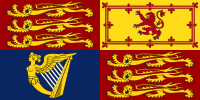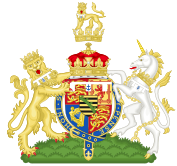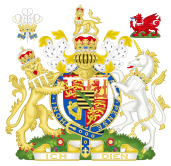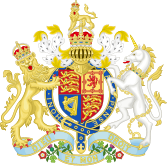George V
| George V | |||||
|---|---|---|---|---|---|
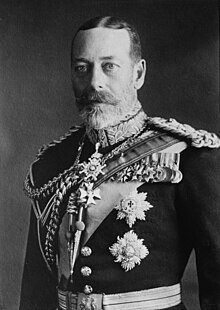 Formal portrait, 1923 | |||||
| Reign | 6 May 1910 –20 January 1936 | ||||
| Coronation | 22 June 1911 | ||||
| Imperial Durbar | 12 December 1911 | ||||
| Predecessor | Edward VII | ||||
| Successor | Edward VIII | ||||
| Born | Prince George of Wales 3 June 1865 Marlborough House,Westminster,Middlesex,England | ||||
| Died | 20 January 1936(aged 70) Sandringham House,Norfolk, England | ||||
| Burial | 28 January 1936 | ||||
| Spouse | |||||
| Issue Detail | |||||
| |||||
| House |
| ||||
| Father | Edward VII | ||||
| Mother | Alexandra of Denmark | ||||
| Religion | Protestant | ||||
| Signature | |||||
| Military career | |||||
| Service | Royal Navy | ||||
| Years of active service | 1877–1892 | ||||
| Rank | Full list | ||||
| Commands | |||||
George V(George Frederick Ernest Albert; 3 June 1865 – 20 January 1936) wasKing of the United Kingdomand theBritish Dominions,andEmperor of India,from 6 May 1910 untilhis deathin 1936.
George was born during the reign of his paternal grandmother,Queen Victoria,as the second son of the Prince and Princess of Wales (laterKing Edward VIIandQueen Alexandra). He was third in the line ofsuccession to the British thronebehind his father and his elder brother,Prince Albert Victor.From 1877 to 1892, George served in theRoyal Navy,until his elder brother's unexpected death in January 1892 put him directly in line for the throne. The next yearGeorge marriedhis brother's former fiancée,Princess Victoria Mary of Teck,and they had six children. WhenQueen Victoria diedin 1901, George's father ascended the throne as Edward VII, and George was createdPrince of Wales.He becameking-emperoronhis father's deathin 1910.
George's reign saw the rise ofsocialism,communism,fascism,Irish republicanism,and theIndian independence movement,all of which radically changed the political landscape of theBritish Empire,which itself reached its territorial peak by the beginning of the 1920s. TheParliament Act 1911established the supremacy of the electedBritish House of Commonsover the unelectedHouse of Lords.As a result of theFirst World War(1914–1918), the empires of his first cousinsNicholas II of RussiaandWilhelm II of Germanyfell, while the British Empire expanded to its greatest effective extent. In 1917, George became the first monarch of theHouse of Windsor,which he renamed from theHouse of Saxe-Coburg and Gothaas a result ofanti-German public sentiment.He appointed thefirst Labour ministryin 1924, and the1931 Statute of Westminsterrecognised the Empire's Dominions as separate, independent states within theBritish Commonwealth of Nations.
George suffered from smoking-related health problems during his later reign. On his death in January 1936, he was succeeded by his eldest son,Edward VIII.Edward abdicatedin December of that year and was succeeded by his younger brother Albert, who took the regnal nameGeorge VI.
Early life and education
[edit]George was born on 3 June 1865, inMarlborough House,London. He was the second son ofAlbert Edward, Prince of Wales,andAlexandra, Princess of Wales.His father was the eldest son ofQueen VictoriaandPrince Albert,and his mother was the eldest daughter ofKing Christian IXandQueen Louise of Denmark.He was baptised atWindsor Castleon 7 July 1865 by theArchbishop of Canterbury,Charles Longley.[a]

As a younger son of the Prince of Wales, there was little expectation that George would become king. He was third in line to the throne, after his father and elder brother,Prince Albert Victor.George was only 17 months younger than Albert Victor, and the two princes were educated together.John Neale Daltonwas appointed as their tutor in 1871. Neither Albert Victor nor George excelled intellectually.[2]As their father thought that the navy was "the very best possible training for any boy",[3]in September 1877, when George was 12 years old, both brothers joined the cadet training shipHMSBritanniaatDartmouth, Devon.[4]
For three years from 1879, the princes served onHMSBacchante,accompanied by Dalton. They toured the colonies of theBritish Empirein theCaribbean,South Africa and Australia, and visitedNorfolk, Virginia,as well as South America, theMediterranean,Egypt, and East Asia. In 1881 on a visit to Japan, George had a local artist tattoo a blue and red dragon on his arm,[5]and was received in an audience by theEmperor Meiji;George and his brother presentedEmpress Harukowith twowallabiesfrom Australia.[6]Dalton wrote an account of their journey entitledThe Cruise of HMS Bacchante.[7]BetweenMelbourneandSydney,Dalton recorded a sighting of theFlying Dutchman,a mythical ghost ship.[8]When they returned to Britain, the Queen complained that her grandsons could not speak French or German, and so they spent six months inLausannein an ultimately unsuccessful attempt to learn another language.[9]After Lausanne, the brothers were separated; Albert Victor attendedTrinity College, Cambridge,while George continued in theRoyal Navy.He travelled the world, visiting many areas of the British Empire. During his naval career he commandedTorpedo Boat 79in home waters, thenHMSThrushon theNorth America and West Indies Station.His last active service was in command ofHMSMelampusin 1891–1892. From then on, his naval rank was largely honorary.[10]
Marriage
[edit]
As a young man destined to serve in the navy, Prince George served for many years under the command of his unclePrince Alfred, Duke of Edinburgh,who was stationed inMalta.There, he grew close to and fell in love with his cousinPrincess Marie of Edinburgh.His grandmother, father and uncle all approved the match, but his own mother andMarie's motheropposed it. The Princess of Wales thought the family was too pro-German, and the Duchess of Edinburgh disliked England. The Duchess, the only daughter ofAlexander II of Russia,resented the fact that, as the wife of a younger son of the British sovereign, she had to yield precedence to George's mother, whose father had been a minor German prince before being called unexpectedly to the throne of Denmark. Guided by her mother, Marie refused George when he proposed to her. She marriedFerdinand, Crown Prince of Romania,in 1893.[11]
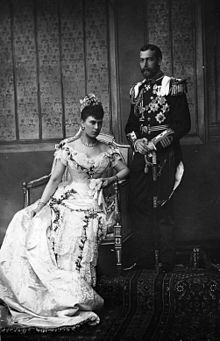
In November 1891, George's brother, Albert Victor, became engaged to his second cousin once removedPrincess Victoria Mary of Teck,known as "May" within the family.[12]Her parents wereFrancis, Duke of Teck(a member of amorganatic,cadet branch of theHouse of Württemberg), andPrincess Mary Adelaide of Cambridge,a male-line granddaughter ofGeorge IIIand a first cousin of Queen Victoria.[13]
On 14 January 1892, six weeks after the formal engagement, Albert Victor died ofpneumoniaduring aninfluenza pandemic,leaving George second in line to the throne and likely to succeed after his father. George had only just recovered from a serious illness himself, having been confined to bed for six weeks withtyphoid fever,the disease that was thought to have killed his grandfather Prince Albert.[14]Queen Victoria still regarded Princess May as a suitable match for her grandson, and George and May grew close during their shared period of mourning.[15]
A year after Albert Victor's death, George proposed to May and was accepted. They married on 6 July 1893 at theChapel RoyalinSt James's Palace,London. Throughout their lives, they remained devoted to each other. George was, on his own admission, unable to express his feelings easily in speech, but they often exchanged loving letters and notes of endearment.[16]
Duke of York
[edit]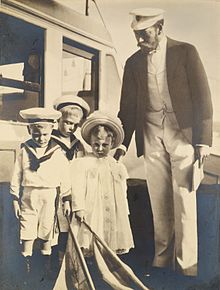
The death of his elder brother effectively ended George's naval career, as he was now second in line to the throne, after his father.[17]George was createdDuke of York,Earl of Inverness,andBaron Killarneyby Queen Victoria on 24 May 1892,[18]and received lessons in constitutional history fromJ. R. Tanner.[19]
The Duke and Duchess of York hadfive sons and a daughter.Randolph Churchillclaimed that George was a strict father, to the extent that his children were terrified of him, and that George had remarked to theEarl of Derby:"My father was frightened of his mother, I was frightened of my father, and I am damned well going to see to it that my children are frightened of me." In reality, there is no direct source for the quotation and it is likely that George's parenting style was little different from that adopted by most people at the time.[20]Whether this was the case or not, his children did seem to resent his strict nature, his sonPrince Henrygoing as far as to describe him as a "terrible father" in later years.[21]
They lived mainly atYork Cottage,[22]a relatively small house inSandringham, Norfolk,where their way of life mirrored that of a comfortable middle-class family rather than royalty.[23]George preferred a simple, almost quiet, life, in marked contrast to the lively social life pursued by his father. His official biographer,Harold Nicolson,later despaired of George's time as Duke of York, writing: "He may be all right as a young midshipman and a wise old king, but when he was Duke of York... he did nothing at all but kill [i.e.shoot] animals and stick in stamps. "[24]George was an avidstamp collector,which Nicolson disparaged,[25]but George played a large role in building theRoyal Philatelic Collectioninto the most comprehensive collection of United Kingdom and Commonwealth stamps in the world, in some cases setting record purchase prices for items.[26]
In October 1894, George's maternal uncle-by-marriage,Alexander III of Russia,died. At the request of his father, "out of respect for poor dear Uncle Sasha's memory", George joined his parents in Saint Petersburg for the funeral.[27]He and his parents remained in Russia forthe weddinga week later of the new Russian emperor, his maternal first cousinNicholas II,to one of George's paternal first cousins,Princess Alix of Hesse and by Rhine,who had once been considered as a potential bride for George's elder brother.[28]
Prince of Wales
[edit]As Duke of York, George carried out a wide variety of public duties. On thedeath of Queen Victoriaon 22 January 1901, George's father ascended the throne asKing Edward VII.[29]George inherited the title ofDuke of Cornwall,and for much of the rest of that year, he was known as the Duke of Cornwall and York.[30]
In 1901, the Duke and Duchess toured theBritish Empire.Their tour included Gibraltar, Malta, Port Said,Aden,Ceylon, Singapore, Australia, New Zealand, Mauritius, South Africa, Canada, and theColony of Newfoundland.The tour was designed by Colonial SecretaryJoseph Chamberlainwith the support of Prime MinisterLord Salisburyto reward the Dominions for their participation in theSouth African Warof 1899–1902. George presented thousands of specially designed South African War medals to colonial troops. In South Africa, the royal party met civic leaders, African leaders, and Boer prisoners, and was greeted by elaborate decorations, expensive gifts, and fireworks displays. Despite this, not all residents responded favourably to the tour. Many white CapeAfrikanersresented the display and expense, the war having weakened their capacity to reconcile their Afrikaner-Dutch culture with their status as British subjects. Critics in the English-language press decried the enormous cost at a time when families faced severe hardship.[31]
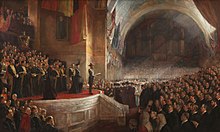
In Australia, George opened the first session of theAustralian Parliamenton thecreation of the Commonwealth of Australia.[32]In New Zealand, he praised the military values, bravery, loyalty, and obedience to duty of New Zealanders, and the tour gave New Zealand a chance to show off its progress, especially in its adoption of up-to-date British standards in communications and the processing industries. The implicit goal was to advertise New Zealand's attractiveness to tourists and potential immigrants, while avoiding news of growing social tensions, by focusing the attention of the British press on a land few knew about.[33]On his return to Britain, in a speech atGuildhall, London,George warned of "the impression which seemed to prevail among [our] brethren across the seas, that the Old Country must wake up if she intends to maintain her old position of pre-eminence in her colonial trade against foreign competitors."[34]
On 9 November 1901, George was createdPrince of WalesandEarl of Chester.[35][36]George's father wished to prepare him for his future role as king. In contrast to Edward himself, whom Queen Victoria had deliberately excluded from state affairs, George was given wide access to state documents by his father.[17][37]George in turn allowed his wife access to his papers,[38]as he valued her counsel and she often helped write his speeches.[39]As Prince of Wales, he supported reforms in naval training, including cadets being enrolled at the ages of twelve and thirteen, and receiving the same education, whatever their class and eventual assignments. The reforms were implemented by the then Second (later First) Sea Lord,Sir John Fisher.[40]
From November 1905 to March 1906, George and May touredBritish India,where he was disgusted by racial discrimination and campaigned for greater involvement of Indians in the government of the country.[41]The tour was almost immediately followed by a trip to Spain for thewedding of King Alfonso XIII to George's cousin Victoria Eugenie of Battenberg,at which the bride and groomnarrowly avoided assassinationwhen the driver of their coach and more than a dozen spectators were killed by a bomb thrown by an anarchist,Mateu Morral.A week after returning to Britain, George and May travelled to Norway for thecoronationofKing Haakon VII,George's cousin and brother-in-law, andQueen Maud,George's sister.[42]
Reign
[edit]
On 6 May 1910,Edward VII died,and George became king. He wrote in his diary:
I have lost my best friend and the best of fathers... I never had a [cross] word with him in my life. I am heart-broken and overwhelmed with grief but God will help me in my responsibilities and darling May will be my comfort as she has always been. May God give me strength and guidance in the heavy task which has fallen on me.[43]
George had never liked his wife's habit of signing official documents and letters as "Victoria Mary" and insisted she drop one of those names. They both thought she should not be called Queen Victoria, and so she became Queen Mary.[44]Later that year, a radical propagandist,Edward Mylius,published a lie that George had secretly married in Malta as a young man, and that consequently his marriage to Queen Mary was bigamous. The lie had first surfaced in print in 1893, but George had shrugged it off as a joke. In an effort to kill off rumours, Mylius was arrested, tried and found guilty ofcriminal libel,and was sentenced to a year in prison.[45]
George objected to theanti-Catholicwording of the Accession Declaration that he would be required to make at the opening of his first parliament. He made it known that he would refuse to open parliament unless it was changed. As a result, theAccession Declaration Act 1910shortened the declaration and removed the most offensive phrases.[46]

George and Mary's coronationtook place atWestminster Abbeyon 22 June 1911,[17]and was celebrated by theFestival of Empirein London. In July, the King and Queen visited Ireland for five days; they received a warm welcome, with thousands of people lining the route of their procession to cheer.[47][48] Later in 1911, the King and Queen travelled to India for theDelhi Durbar,where they were presented to an assembled audience of Indian dignitaries and princes as theEmperor and Empress of Indiaon 12 December 1911. George wore the newly createdImperial Crown of Indiaat the ceremony and declared the shifting of the Indian capital fromCalcuttato Delhi. He was the only Emperor of India to be present at his own Delhi Durbar.
As he and Mary travelled throughout the subcontinent, George took the opportunity to indulge inbig game hunting in Nepal,shooting 21 tigers, 8 rhinoceroses and a bear over 10 days.[49]He was a keen and expert marksman.[50]On a later occasion, on 18 December 1913, he shot over a thousandpheasantsin six hours (about one bird every 20 seconds) while visiting the home ofLord Burnham.Even George had to acknowledge that "we went a little too far" that day.[51]
National politics
[edit]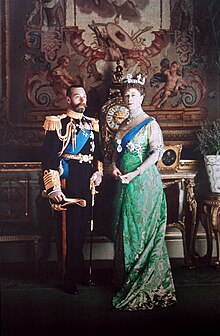
George inherited the throne at a politically turbulent time.[52]Lloyd George'sPeople's Budgethad been rejected the previous year by theConservativeandUnionist-dominatedHouse of Lords,contrary to the normal convention that the Lords did not vetomoney bills.[53]LiberalPrime MinisterH. H. Asquithhad asked the previous king to give an undertaking that he would create sufficient Liberal peers to allow the passage of Liberal legislation. Edward had reluctantly agreed, provided the Lords rejected the budget after two successive general elections. After theJanuary 1910 general election,the Conservative peers allowed the budget, for which the government now had an electoral mandate, to pass without a vote.[54]

Asquith attempted to curtail the power of the Lords through constitutional reforms, which were again blocked by the Upper House. A constitutional conference on the reforms broke down in November 1910 after 21 meetings. Asquith andLord Crewe,Liberal leader in the Lords, asked George to grant a dissolution, leading to a second general election, and to promise to create sufficient Liberal peers if the Lords blocked the legislation again.[55]If George refused, the Liberal government would otherwise resign, which would have given the appearance that the monarch was taking sides – with "the peers against the people" – in party politics.[56]The King's two private secretaries, the LiberalLord Knollysand the UnionistLord Stamfordham,gave George conflicting advice.[57][58]Knollys advised George to accept the Cabinet's demands, while Stamfordham advised George to accept the resignation.[57]Like his father, George reluctantly agreed to the dissolution and creation of peers, although he felt his ministers had taken advantage of his inexperience to browbeat him.[59]After theDecember 1910 general election,the Lords let the bill pass on hearing of the threat to swamp the house with new peers.[60]The subsequentParliament Act 1911permanently removed – with a few exceptions – the power of the Lords to veto bills. George later came to feel that Knollys had withheld information from him about the willingness of the opposition to form a government if the Liberals had resigned.[61]
The 1910 general elections had left the Liberals as a minority government dependent upon the support of theIrish Nationalist Party.As desired by the Nationalists, Asquith introducedlegislation that would give Ireland Home Rule,but the Conservatives and Unionists opposed it.[17][62]As tempers rose over the Home Rule Bill, which would never have been possible without the Parliament Act, relations between the elderly Knollys and the Conservatives became poor, and he was pushed into retirement.[63]Desperate to avoid the prospect of civil war in Ireland between Unionists and Nationalists, George called ameeting of all parties at Buckingham Palacein July 1914 in an attempt to negotiate a settlement.[64]After four days the conference ended without an agreement.[17][65]Political developments in Britain and Ireland were overtaken by events in Europe, and the issue of Irish Home Rule wassuspendedfor the duration of the war.[17][66]
First World War
[edit]
On 4 August 1914, George wrote in his diary, "I held a council at 10:45 to declare war with Germany. It is a terrible catastrophe but it is not our fault.... Please to God it may soon be over."[67]From 1914 to 1918,Britain and its allieswere atwarwith theCentral Powers,led by theGerman Empire.German Kaiser Wilhelm II,who for the British public came to symbolise all the horrors of the war, was the King's first cousin. George's paternal grandfather wasPrince Albert of Saxe-Coburg and Gotha;consequently, the King and his children bore the German titles Prince and Princess of Saxe-Coburg and Gotha and Duke and Duchess of Saxony. Queen Mary, although born in England like her mother, was the daughter of the Duke of Teck, a descendant of the GermanDukes of Württemberg.George had brothers-in-law and cousins who were British subjects but who bore German titles such as Duke and Duchess of Teck, Prince and Princess of Battenberg, and Prince and Princess of Schleswig-Holstein. WhenH. G. Wellswrote about Britain's "alien and uninspiring court", George replied: "I may be uninspiring, but I'll be damned if I'm alien."[68]
On 17 July 1917, George appeased British nationalist feelings by issuing a royal proclamation that changed the name of the Britishroyal housefrom the German-soundingHouse of Saxe-Coburg and Gothato theHouse of Windsor.[69]He and all his British relatives relinquished their German titles and styles and adopted British-sounding surnames. George compensated his male relatives by giving them British peerages. His cousinPrince Louis of Battenberg,who earlier in the war had been forced to resign asFirst Sea Lordthrough anti-German feeling, became Louis Mountbatten, 1st Marquess of Milford Haven, while Queen Mary's brothers becameAdolphus Cambridge, 1st Marquess of Cambridge,andAlexander Cambridge, 1st Earl of Athlone.[70]

Inletters patentgazetted on 11 December 1917, the King restricted the style of "Royal Highness" and the titular dignity of "Prince (or Princess) of Great Britain and Ireland" to the children of the Sovereign, the children of the sons of the Sovereign and the eldest living son of the eldest son of a Prince of Wales.[71]The letters patent also stated that "the titles of Royal Highness, Highness or Serene Highness, and the titular dignity of Prince and Princess shall cease except those titles already granted and remaining unrevoked". George's relatives who fought on the German side, such asErnest Augustus, Crown Prince of Hanover,andCharles Edward, Duke of Saxe-Coburg and Gotha,had their British peerages suspended by a 1919Order in Councilunder the provisions of theTitles Deprivation Act 1917.Under pressure from his mother, George also removed theGarter flagsof his German relations fromSt George's Chapel, Windsor Castle.[72]
When Tsar Nicholas II of Russia, George's first cousin, was overthrown in theRussian Revolution of 1917,the British government offeredpolitical asylumto the Tsar and his family, but worsening conditions for the British people, and fears that revolution might come to the British Isles, led George to think that the presence of theRomanovswould be seen as inappropriate.[73]Despite the later claims ofLord Mountbatten of Burmathat Prime MinisterDavid Lloyd Georgewas opposed to the rescue of the Russian imperial family, the letters of Lord Stamfordham suggest that it was George V who opposed the idea against the advice of the government.[74]Advance planning for a rescue was undertaken byMI1,a branch of the British secret service,[75]but because of the strengthening position of theBolshevikrevolutionaries and wider difficulties with the conduct of the war, the plan was never put into operation.[76]Nicholas and his immediate family remained in Russia, where they werekilled by the Bolsheviks in 1918.George wrote in his diary: "It was a foul murder. I was devoted to Nicky, who was the kindest of men and thorough gentleman: loved his country and people."[77]The following year, Nicholas's mother,Marie Feodorovna,and other members of the extended Russian imperial family were rescued fromCrimeaby a British warship.[78]
Two months after the end of the war, the King's youngest son,John,died aged 13 after a lifetime of ill health. George was informed of his death by Queen Mary, who wrote, "[John] had been a great anxiety to us for many years... The first break in the family circle is hard to bear but people have been so kind & sympathetic & this has helped us much."[79]
In May 1922, George toured Belgium and northern France, visiting the First World War cemeteries and memorials being constructed by theImperial War Graves Commission.The event was described in a poem, "The King's Pilgrimage"byRudyard Kipling.[80]The tour, and one short visit to Italy in 1923, were the only times George agreed to leave the United Kingdom on official business after the end of the war.[81]
Post-war reign
[edit]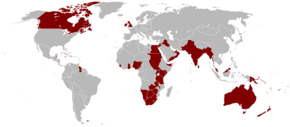
Before theFirst World War,most of Europe was ruled by monarchs related to George, but during and after the war, the monarchies of Austria, Germany, Greece, and Spain, like Russia, fell to revolution and war. In March 1919, Lieutenant-ColonelEdward Lisle Struttwas dispatched on the personal authority of the King to escort the former EmperorCharles I of Austriaand his family to safety in Switzerland.[83]In 1922, aRoyal Navyship was sent to Greece to rescue his cousinsPrinceandPrincess Andrew.[84]
Political turmoil in Ireland continued as the Nationalistsfought for independence;George expressed his horror at government-sanctioned killings and reprisals to Prime MinisterLloyd George.[85]At the opening session of theParliament of Northern Irelandon 22 June 1921, the King appealed for conciliation in a speech part drafted by GeneralJan Smutsand approved by Lloyd George.[86]A few weeks later, a truce was agreed.[87]Negotiations between Britain and the Irish secessionists led to the signing of theAnglo-Irish Treaty.[88]By the end of 1922,Ireland was partitioned,theIrish Free Statewas established, and Lloyd George was out of office.[89]
George and his advisers were concerned about the rise of socialism and the growing labour movement, which they mistakenly associated with republicanism. The socialists no longer believed in their anti-monarchical slogans and were ready to come to terms with the monarchy if it took the first step. George adopted a more democratic, inclusive stance that crossed class lines and brought the monarchy closer to the public and the working class—a dramatic change for the King, who was most comfortable with naval officers and landed gentry. He cultivated friendly relations with moderateLabour Partypoliticians and trade union officials. His abandonment of social aloofness conditioned the royal family's behaviour and enhanced its popularity during the economic crises of the 1920s and for over two generations thereafter.[90][91]
The years between 1922 and 1929 saw frequent changes in government. In 1924, George appointed the first Labour Prime Minister,Ramsay MacDonald,in the absence of a clear majority for any one of the three major parties. George's tact in appointing the first Labour government (which lasted less than a year) allayed the suspicions of the party's sympathisers that he would work against their interests. During theGeneral Strike of 1926,George advised the government ofConservativeStanley Baldwinagainst taking inflammatory action,[92]and took exception to suggestions that the strikers were "revolutionaries" saying, "Try living on their wages before you judge them."[93]
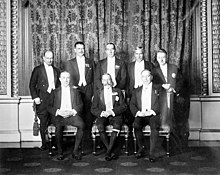
In 1926, George hosted anImperial Conferencein London at which theBalfour Declarationaccepted the growth of theBritish Dominionsinto self-governing "autonomous Communities within the British Empire, equal in status, in no way subordinate one to another". TheStatute of Westminster 1931formalised the Dominions' legislative independence[94]and established that the succession to the throne could not be changed unless all the Parliaments of the Dominions as well as the Parliament at Westminster agreed.[17]The Statute's preamble described the monarch as "the symbol of the free association of the members of the British Commonwealth of Nations", who were "united by a common allegiance".[95]
In the wake of aworld financial crisis,George encouraged the formation of aNational Governmentin 1931 led by MacDonald and Baldwin,[96][b] and volunteered to reduce thecivil listto help balance the budget.[96]He was concerned by the rise to power inGermanyofAdolf Hitlerand theNazi Party.[99]In 1934, George bluntly told the German ambassadorLeopold von Hoeschthat Germany was now the peril of the world, and that there was bound to be a war within ten years if Germany went on at the present rate; he warned the British ambassador in Berlin,Eric Phipps,to be suspicious of the Nazis.[100]

In 1932, George agreed to deliver aRoyal Christmas speechon the radio, an event that became annual thereafter. He was not in favour of the innovation originally but was persuaded by the argument that it was what his people wanted.[101]By theSilver Jubileeof his reign in 1935, he had become a well-loved king, saying in response to the crowd's adulation, "I cannot understand it, after all I am only a very ordinary sort of fellow."[102]
George's relationship with his eldest son and heir,Edward,deteriorated in these later years. George was disappointed in Edward's failure to settle down in life and appalled by his many affairs with married women.[17]In contrast, he was fond of his second son, Prince Albert (laterGeorge VI), and doted on his eldest granddaughter,Princess Elizabeth;he nicknamed her "Lilibet", and she affectionately called him "Grandpa England".[103]In 1935, George said of his son Edward: "After I am dead, the boy will ruin himself within 12 months", and of Albert and Elizabeth: "I pray to God my eldest son will never marry and have children, and that nothing will come between Bertie and Lilibet and the throne".[104][105]
Declining health and death
[edit]
The First World War took a toll on George's health: he was seriously injured on 28 October 1915 when thrown by his horse at a troop review in France,[106]and his heavy smoking exacerbated recurring breathing problems. He suffered fromchronic bronchitis.In 1925, on the instruction of his doctors, he was reluctantly sent on a recuperative private cruise in the Mediterranean; it was his third trip abroad since the war, and his last.[107]In November 1928, he fell seriously ill withsepticaemia,which localised between the base of his right lung and diaphragm in the form of anempyemathat requireddrainage.[108]For the next two years his son Edward took over many of his duties.[109]In 1929, the suggestion of a further rest abroad was rejected by the King "in rather strong language".[110]Instead, he retired for three months toCraigweil House,Aldwick, in the seaside resort ofBognor,Sussex.[111]As a result of his stay, the town acquired the suffixRegis– Latin for "of the King". A myth later grew that his last words, on being told that he would soon be well enough to revisit the town, were "BuggerBognor! "[112][113][114]
George never fully recovered. In his final year, he was occasionally administered oxygen.[115]The death of his favourite sister,Victoria,in December 1935 depressed him deeply. On the evening of 15 January 1936, George took to his bedroom atSandringham Housecomplaining of a cold; he remained in the room until his death.[116]He became gradually weaker, drifting in and out of consciousness. Prime Minister Stanley Baldwin later said:
... each time he became conscious it was some kind inquiry or kind observation of someone, some words of gratitude for kindness shown. But he did say to his secretary when he sent for him: "How is the Empire?" An unusual phrase in that form, and the secretary said: "All is well, sir, with the Empire", and the King gave him a smile and relapsed once more into unconsciousness.[117]
By 20 January, George was close to death. His physicians, led byLord Dawson of Penn,issued a bulletin with the words "The King's life is moving peacefully towards its close."[118][119]Dawson's private diary, unearthed after his death and made public in 1986, reveals that George's last words, a mumbled "God damn you!",[120]were addressed to his nurse,Catherine Black,when she gave him a sedative that night. Dawson, who supported the "gentle growth ofeuthanasia",[121]admitted in the diary that he ended the King's life:[120][122][123]
At about 11 o'clock it was evident that the last stage might endure for many hours, unknown to the Patient but little comporting with that dignity and serenity which he so richly merited and which demanded a brief final scene. Hours of waiting just for the mechanical end when all that is really life has departed only exhausts the onlookers & keeps them so strained that they cannot avail themselves of the solace of thought, communion or prayer. I therefore decided to determine the end and injected (myself) morphia gr.3/4 [grains] and shortly afterwards cocaine gr.1 [grains] into the distended jugular vein... In about 1/4 an hour – breathing quieter – appearance more placid – physical struggle gone.[123]
Dawson wrote that he acted to preserve the King's dignity, to prevent further strain on the family, and so that George's death at 11:55 pm could be announced in the morning edition ofThe Timesnewspaper rather than "less appropriate... evening journals".[120][122]Neither Queen Mary, who was intensely religious and might not have sanctioned euthanasia, nor the Prince of Wales were consulted. The royal family did not want the King to endure pain and suffering and did not want his life prolonged artificially but neither did they approve Dawson's actions.[124]British Pathéannounced the King's death the following day, in which he was described as "for each one of us, more than a King, a father of a great family".[125]
The German composerPaul Hindemithwent to a BBC studio on the morning after the King's death and in six hours wroteTrauermusik( "Mourning Music" ), for viola and orchestra. It was performed that same evening in a live broadcast by theBBC,withAdrian Boultconducting theBBC Symphony Orchestraand the composer as soloist.[126] At the procession to George'slying in stateinWestminster Hall,the cross surmounting theImperial State Crownatop George's coffin fell off and landed in the gutter as the cortège turned intoNew Palace Yard.George's eldest son and successor, Edward VIII, saw it fall and wondered whether it was a bad omen for his new reign.[127]As a mark of respect to their father, George's four surviving sons – Edward,Albert,Henry,andGeorge– mounted the guard, known as theVigil of the Princes,at thecatafalqueon the night before thefuneral.[128]The vigil was not repeated until the death of George's daughter-in-law,Queen Elizabeth The Queen Mother,in 2002. George V was interred at St George's Chapel, Windsor Castle, on 28 January 1936.[129]Edwardabdicatedbefore the year was out, leaving Albert to ascend the throne as George VI.[130]
Legacy
[edit]
George V disliked sitting for portraits[17]and despisedmodern art;he was so displeased by one portrait byCharles Simsthat he ordered it to be burned.[131]He did admire sculptorBertram Mackennal,who created statues of George for display in Madras and Delhi, andWilliam Reid Dick,whosestatue of George Vstands outsideWestminster Abbey,London.[17]
Although he and his wife occasionally toured theBritish Empire,George preferred to stay at home pursuing his hobbies ofstamp collectingandgame shootingand lived a life that later biographers would consider dull because of its conventionality.[132]He was not an intellectual: on returning from one evening at the opera he wrote, "Went toCovent Gardenand sawFidelioand damned dull it was. "[133]He was earnestly devoted to Britain and its Empire.[134]He explained, "it has always been my dream to identify myself with the great idea of Empire."[135]He appeared hard-working and became widely admired by the people of Britain and the Empire, as well as "the Establishment".[136]In the words of historianDavid Cannadine,King George V and Queen Mary were an "inseparably devoted couple" who upheld "character" and "family values".[137]
George established a standard of conduct for British royalty that reflected the values and virtues of the upper middle-class rather than upper-class lifestyles or vices.[138]Acting within his constitutional bounds, he dealt skilfully with a succession of crises: Ireland, the First World War, and the first socialist minority government in Britain.[17]He was by temperament a traditionalist who never fully appreciated or approved the revolutionary changes under way in British society.[139]Nevertheless, he invariably wielded his influence as a force of neutrality and moderation, seeing his role as mediator rather than final decision maker.[140]
Titles, honours and arms
[edit]As Duke of York, George's arms were theroyal arms,with aninescutcheonof thearms of Saxony,all differenced with alabelof three pointsargent,the centre point bearing an anchorazure.The anchor was removed from hiscoat of arms as the Prince of Wales.As King, he bore the royal arms. In 1917, he removed, by warrant, the Saxony inescutcheon from the arms of all male-line descendants of the Prince Consort domiciled in the United Kingdom (although the royal arms themselves had never borne the shield).[141]
Issue
[edit]| Name | Birth | Death | Marriage | Their children | ||
|---|---|---|---|---|---|---|
| Date | Spouse | |||||
| Edward VIII (laterDuke of Windsor) |
23 June 1894 | 28 May 1972(aged 77) | 3 June 1937 | Wallis Simpson | None | |
| George VI | 14 December 1895 | 6 February 1952(aged 56) | 26 April 1923 | Lady Elizabeth Bowes-Lyon | Elizabeth II | |
| Princess Margaret, Countess of Snowdon | ||||||
| Mary, Princess Royal | 25 April 1897 | 28 March 1965(aged 67) | 28 February 1922 | Henry Lascelles, 6th Earl of Harewood | George Lascelles, 7th Earl of Harewood | |
| The Hon. Gerald Lascelles | ||||||
| Prince Henry, Duke of Gloucester | 31 March 1900 | 10 June 1974(aged 74) | 6 November 1935 | Lady Alice Montagu Douglas Scott | Prince William of Gloucester | |
| Prince Richard, Duke of Gloucester | ||||||
| Prince George, Duke of Kent | 20 December 1902 | 25 August 1942(aged 39) | 29 November 1934 | Princess Marina of Greece and Denmark | Prince Edward, Duke of Kent | |
| Princess Alexandra, The Honourable Lady Ogilvy | ||||||
| Prince Michael of Kent | ||||||
| Prince John | 12 July 1905 | 18 January 1919(aged 13) | None | None | ||
Ancestry
[edit]See also
[edit]- Household of George V and Mary
- Interwar Britain
- List of covers of Time magazine (1920s),(1930s)
- King George's Fields
Notes
[edit]- ^ His godparents were theKing of Hanover(Queen Victoria's cousin, for whomPrince Edward of Saxe-Weimar-Eisenachstood proxy); theDuke of Saxe-Coburg and Gotha(Prince Albert's brother, for whom theLord President of the Council,Earl Granville,stood proxy); thePrince of Leiningen(the Prince of Wales's half-cousin); theCrown Prince of Denmark(the Princess of Wales's brother, for whom theLord Chamberlain,Viscount Sydney,stood proxy); theQueen of Denmark(George's maternal grandmother, for whom Queen Victoria stood proxy); theDuke of Cambridge(Queen Victoria's cousin); theDuchess of Cambridge(Queen Victoria's aunt, for whom George's auntPrincess Helenastood proxy); andPrincess Louis of Hesse and by Rhine(George's aunt, for whom her sisterPrincess Louisestood proxy).[1]
- ^ Vernon Bogdanorargues that George V played a crucial and active role in the political crisis of August–October 1931, and was a determining influence on Prime Minister MacDonald.[97]Philip Williamsondisputes Bogdanor, saying the idea of a national government had been in the minds of party leaders since late 1930 and it was they, not the King, who determined when the time had come to establish one.[98]
References
[edit]- ^The Times(London), Saturday, 8 July 1865, p. 12.
- ^Clay, p. 39; Sinclair, pp. 46–47
- ^Sinclair, pp. 49–50
- ^Clay, p. 71; Rose, p. 7
- ^Rose, p. 13
- ^Keene, Donald (2002),Emperor of Japan: Meiji and his world, 1852–1912,Columbia University Press, pp. 350–351
- ^Rose, p. 14; Sinclair, p. 55
- ^Rose, p. 11
- ^Clay, p. 92; Rose, pp. 15–16
- ^Sinclair, p. 69
- ^Pope-Hennessy, pp. 250–251
- ^Rose, pp. 22–23
- ^Rose, p. 29
- ^Rose, pp. 20–21, 24
- ^Pope-Hennessy, pp. 230–231
- ^Sinclair, p. 178
- ^abcdefghijkMatthew, H. C. G.(September 2004; online edition May 2009),"George V (1865–1936)",Oxford Dictionary of National Biography,Oxford University Press,doi:10.1093/ref:odnb/33369,retrieved 1 May 2010 (Subscription required)
- ^Clay, p. 149
- ^Clay, p. 150; Rose, p. 35
- ^Rose, pp. 53–57; Sinclair, p. 93ff
- ^Vickers, ch. 18
- ^Renamed fromBachelor's Cottage
- ^Clay, p. 154; Nicolson, p. 51; Rose, p. 97
- ^Harold Nicolson's diary quoted in Sinclair, p. 107
- ^Nicolson'sComments 1944–1948,quoted in Rose, p. 42
- ^The Royal Philatelic Collection,Official website of the British Monarchy,archivedfrom the original on 15 April 2012,retrieved1 May2010
- ^Clay, p. 167
- ^Rose, pp. 22, 208–209
- ^Rose, p. 42
- ^Rose, pp. 44–45
- ^Buckner, Phillip (November 1999), "The Royal Tour of 1901 and the Construction of an Imperial Identity in South Africa",South African Historical Journal,41:324–348,doi:10.1080/02582479908671897
- ^Rose, pp. 43–44
- ^Bassett, Judith (1987), "'A Thousand Miles of Loyalty': the Royal Tour of 1901 ",New Zealand Journal of History,21(1): 125–138;Oliver, W. H., ed. (1981),The Oxford History of New Zealand,pp. 206–208
- ^Rose, p. 45
- ^"No. 27375",The London Gazette,9 November 1901, p. 7289
{{cite magazine}}:CS1 maint: overridden setting (link) - ^Previous Princes of Wales,Household of HRH The Prince of Wales,archivedfrom the original on 19 April 2020,retrieved19 March2018
- ^Clay, p. 244; Rose, p. 52
- ^Rose, p. 289
- ^Sinclair, p. 107
- ^Massie, Robert K.(1991),Dreadnought: Britain, Germany and the Coming of the Great War,Random House, pp. 449–450
- ^Rose, pp. 61–66
- ^Rose, pp. 67–68
- ^King George V's diary, 6 May 1910, Royal Archives, quoted in Rose, p. 75
- ^Pope-Hennessy, p. 421; Rose, pp. 75–76
- ^Rose, pp. 82–84
- ^Wolffe, John (2010),"Protestantism, Monarchy and the Defence of Christian Britain 1837–2005",in Brown, Callum G.; Snape, Michael F. (eds.),Secularisation in the Christian World,Farnham, Surrey: Ashgate Publishing, pp. 63–64,ISBN978-0-7546-9930-9,archivedfrom the original on 17 June 2016,retrieved28 November2015
- ^Rayner, Gordon (10 November 2010),"How George V was received by the Irish in 1911",The Telegraph,archived fromthe originalon 18 April 2018
- ^"The queen in 2011... the king in 1911",the Irish Examiner,11 May 2011,archivedfrom the original on 13 August 2014,retrieved13 August2014
- ^Rose, p. 136
- ^Rose, pp. 39–40
- ^Rose, p. 87; Windsor, pp. 86–87
- ^Rose, p. 115
- ^Rose, pp. 112–114
- ^Rose, p. 114
- ^Rose, pp. 116–121
- ^Rose, pp. 121–122
- ^abRose, pp. 120, 141
- ^Hardy, Frank (May 1970), "The King and the constitutional crisis",History Today,vol. 20, no. 5, pp. 338–347
- ^Rose, pp. 121–125
- ^Rose, pp. 125–130
- ^Rose, p. 123
- ^Rose, p. 137
- ^Rose, pp. 141–143
- ^Rose, pp. 152–153, 156–157
- ^Rose, p. 157
- ^Rose, p. 158
- ^Nicolson, p. 247
- ^Nicolson, p. 308
- ^"No. 30186",The London Gazette,17 July 1917, p. 7119
{{cite magazine}}:CS1 maint: overridden setting (link) - ^Rose, pp. 174–175
- ^Nicolson, p. 310
- ^Clay, p. 326; Rose, p. 173
- ^Nicolson, p. 301; Rose, pp. 210–215; Sinclair, p. 148
- ^Rose, p. 210
- ^Crossland, John (15 October 2006), "British spies in plot to save Tsar",The Sunday Times
- ^Sinclair, p. 149
- ^Diary, 25 July 1918, quoted in Clay, p. 344 and Rose, p. 216
- ^Clay, pp. 355–356
- ^Pope-Hennessy, p. 511
- ^Pinney, Thomas, ed. (1990),The Letters of Rudyard Kipling 1920–30,vol. 5, University of Iowa Press, note 1, p. 120,ISBN978-0-87745-898-2
- ^Rose, p. 294
- ^Rein Taagepera(September 1997),"Expansion and Contraction Patterns of Large Polities: Context for Russia",International Studies Quarterly,41(3): 475–504,doi:10.1111/0020-8833.00053,JSTOR2600793,archivedfrom the original on 19 November 2018,retrieved28 December2018
- ^"Archduke Otto von Habsburg",The Daily Telegraph(obituary), London, UK, 4 July 2011,archivedfrom the original on 24 December 2019,retrieved4 April2018
- ^Rose, pp. 347–348
- ^Nicolson, p. 347; Rose, pp. 238–241; Sinclair, p. 114
- ^Mowat, p. 84
- ^Mowat, p. 86
- ^Mowat, pp. 89–93
- ^Mowat, pp. 106–107, 119
- ^Prochaska, Frank (1999), "George V and Republicanism, 1917–1919",Twentieth Century British History,10(1): 27–51,doi:10.1093/tcbh/10.1.27
- ^Kirk, Neville (2005), "The Conditions of Royal Rule: Australian and British Socialist and Labour Attitudes to the Monarchy, 1901–11",Social History,30(1): 64–88,doi:10.1080/0307102042000337297,S2CID144979227
- ^Nicolson, p. 419; Rose, pp. 341–342
- ^Rose, p. 340; Sinclair, p. 105
- ^Rose, p. 348
- ^"Statute of Westminster 1931",legislation.gov.uk,archivedfrom the original on 24 December 2012,retrieved20 July2017
- ^abRose, pp. 373–379
- ^ Bogdanor, V.(1991), "1931 Revisited: The constitutional aspects",Twentieth Century British History,2(1): 1–25,doi:10.1093/tcbh/2.1.1
- ^ Williamson, Philip(1991), "1931 Revisited: The political realities",Twentieth Century British History,2(3): 328–338,doi:10.1093/tcbh/2.3.328
- ^Nicolson, pp. 521–522; Owens, pp. 92–93; Rose, p. 388
- ^Nicolson, pp. 521–522; Rose, p. 388
- ^Sinclair p. 154
- ^Sinclair, p. 1
- ^Pimlott, Ben(1996),The Queen,John Wiley and Sons,ISBN978-0-471-19431-6
- ^Ziegler, Philip(1990),King Edward VIII: The Official Biography,London: Collins, p. 199,ISBN978-0-00-215741-4
- ^Rose, p. 392
- ^Windsor, pp. 118–119
- ^Rose, pp. 301, 344
- ^"The Illness of H. M. the King-Emperor",The Indian Medical Gazette,64(3): 151–152, March 1929,PMC5164308,PMID29009522
- ^Ziegler, pp. 192–196
- ^Arthur Bigge, 1st Baron Stamfordham,toAlexander Cambridge, 1st Earl of Athlone,9 July 1929, quoted in Nicolson p. 433 and Rose, p. 359
- ^Pope-Hennessy, p. 546; Rose, pp. 359–360
- ^Roberts, Andrew(2000),Fraser, Antonia(ed.),The House of Windsor,London, UK: Cassell and Co., p. 36,ISBN978-0-304-35406-1
- ^Ashley, Mike(1998),The Mammoth Book of British Kings and Queens,London, UK: Robinson Publishing, p. 699
- ^Rose, pp. 360–361
- ^Bradford, Sarah (1989),King George VI,London, UK: Weidenfeld and Nicolson, p. 149,ISBN978-0-297-79667-1
- ^Pope-Hennessy, p. 558
- ^The Times(London), 22 January 1936, p. 7, col. A
- ^The Times(London), 21 January 1936, p. 12, col. A
- ^Rose, p. 402
- ^abcWatson, Francis (1986), "The death of George V",History Today,vol. 36, pp. 21–30,PMID11645856
- ^Lelyveld, Joseph (28 November 1986),"1936 Secret is out: Doctor sped George V's death",The New York Times,pp. A1, A3,PMID11646481,archivedfrom the original on 8 October 2016,retrieved18 September2016
- ^abRamsay, J.H.R. (28 May 1994), "A king, a doctor, and a convenient death",British Medical Journal,308(6941): 1445,doi:10.1136/bmj.308.6941.1445,PMC2540387,PMID11644545(Subscription required)
- ^abMatson, John (1 January 2012),Sandringham Days: The Domestic Life of the Royal Family in Norfolk,1862–1952,The History Press,ISBN9780752483115
{{cite book}}:CS1 maint: overridden setting (link) - ^"Doctor murdered Britain's George V",Observer-Reporter,Washington (PA), 28 November 1986,archivedfrom the original on 3 November 2020,retrieved18 September2016
- ^The death of His Majesty King George V 1936(short film / newsreel),British Pathé,23 January 1936,archivedfrom the original on 4 May 2016,retrieved18 September2016
- ^Steinberg, Michael (2000),The Concerto,Oxford University Press, pp. 212–213,ISBN978-0-19-513931-0,archivedfrom the original on 8 October 2021,retrieved11 November2020
- ^Windsor, p. 267
- ^The Times(London), Tuesday, 28 January 1936, p. 10, col. F
- ^Rose, pp. 404–405
- ^"No. 34350",The London Gazette,15 December 1936, p. 8117
{{cite magazine}}:CS1 maint: overridden setting (link) - ^Rose, p. 318
- ^e.g.Harold Nicolson's diary quoted by Sinclair, p. 107;Best, Nicholas(1995),The Kings and Queens of England,London, UK: Weidenfeld & Nicolson, p. 83,ISBN0-297-83487-8,
rather a dull man... liked nothing better than to sit in his study and look at his stamps
;Lacey, Robert(2002),Royal,London, UK: Little, Brown, p. 54,ISBN0-316-85940-0,the diary of King George V is the journal of a very ordinary man, containing a great deal more about his hobby of stamp collecting than it does about his personal feelings, with a heavy emphasis on the weather.
- ^Pierce, Andrew (4 August 2009),"Buckingham Palace is unlikely shrine to the history of jazz",The Telegraph,London,archivedfrom the original on 27 December 2019,retrieved11 February2012
- ^Clay, p. 245; Gore, p. 293; Nicolson, pp. 33, 141, 510, 517
- ^Harrison, Brian (1996),The Transformation of British Politics, 1860–1995,pp. 320, 337
- ^Gore, pp. x, 116
- ^Cannadine, David (1998),History in our Time,p. 3
- ^Harrison, p. 332;"The King of England: George V",Fortune,p. 33, 1936,
if not himself a characteristic example of the great British middle class, is so like the characteristic examples of that class that there is no perceptible distinction to be made between the two.
- ^Rose, p. 328
- ^Harrison, pp. 51, 327
- ^Velde, François (19 April 2008),"Marks of Cadency in the British Royal Family"Archived17 March 2018 at theWayback Machine,Heraldica, retrieved 1 May 2010
- ^Louda, Jiří;Maclagan, Michael(1999),Lines of Succession: Heraldry of the Royal Families of Europe,London: Little, Brown, pp. 34, 51,ISBN978-1-85605-469-0
Works cited
[edit]- Clay, Catrine (2006),King, Kaiser, Tsar: Three Royal Cousins Who Led the World to War,London: John Murray,ISBN978-0-7195-6537-3
- Gore, John (1941),King George V: a personal memoir
- Matthew, H. C. G.(September 2004; online edition May 2009),"George V (1865–1936)",Oxford Dictionary of National Biography,Oxford University Press,doi:10.1093/ref:odnb/33369,retrieved 1 May 2010 (Subscription required)
- Mowat, Charles Loch(1955),Britain Between The Wars 1918–1940,London: Methuen
- Nicolson, Sir Harold(1952),King George the Fifth: His Life and Reign,London: Constable and Co
- Owens, Edward (2019), "2: 'A man we understand': King George V's radio broadcasts",The Family Firm: monarchy, mass media and the British public, 1932–53,pp. 91–132,ISBN9781909646940,JSTORj.ctvkjb3sr.8
- Pope-Hennessy, James(1959),Queen Mary,London: George Allen and Unwin, Ltd
- Rose, Kenneth(1983),King George V,London: Weidenfeld and Nicolson,ISBN978-0-297-78245-2
- Sinclair, David (1988),Two Georges: The Making of the Modern Monarchy,London: Hodder and Stoughton,ISBN978-0-340-33240-5
- Vickers, Hugo(2018),The Quest for Queen Mary,London: Zuleika
- Windsor, HRH The Duke of(1951),A King's Story,London: Cassell and Co
Further reading
[edit]- Cannadine, David(2014),George V: The Unexpected King
- Chisholm, Hugh(1922),,Encyclopædia Britannica,vol. 31 (12th ed.)
{{cite encyclopedia}}:CS1 maint: overridden setting (link) - Mort, Frank (2019),"Safe for Democracy: Constitutional Politics, Popular Spectacle, and the British Monarchy 1910–1914",Journal of British Studies,58(1): 109–141,doi:10.1017/jbr.2018.176,S2CID151146689
- Ridley, Jane(2022),George V: Never a Dull Moment,excerpt
- Somervell, D. C.(1936),The Reign of King George V,wide-ranging political, social and economic coverage, 1910–35
- Spender, John A. (1935), "British Foreign Policy in the Reign of HM King George V",International Affairs,14(4): 455–479,JSTOR2603463
External links
[edit]- George Vat the official website of theBritish monarchy
- George Vat the official website of theRoyal Collection Trust
- George VatBBC History
- Portraits of King George Vat theNational Portrait Gallery, London
- George V
- 1865 births
- 1936 deaths
- 19th-century British people
- 20th-century British Army personnel
- 20th-century British monarchs
- House of Windsor
- Kings of the Irish Free State
- 20th-century Royal Marines personnel
- 20th-century Royal Navy personnel
- British field marshals
- British people of Danish descent
- British people of German descent
- British philatelists
- Burials at St George's Chapel, Windsor Castle
- Chancellors of the University of Cape Town
- Children of Edward VII
- Deaths by euthanasia
- Drug-related deaths in England
- Dukes of Cornwall
- Dukes of Rothesay
- Dukes of York
- Earls of Inverness
- Emperors of India
- English hunters
- Fellows of the Royal Society
- Field marshals of the German Empire
- Heads of state of Australia
- Heads of state of Canada
- Heads of state of New Zealand
- Heirs to the British throne
- Lord high stewards of Scotland
- House of Saxe-Coburg and Gotha (United Kingdom)
- Lords Warden of the Cinque Ports
- Members of the Privy Council of Ireland
- Members of the Privy Council of the United Kingdom
- Monarchs in South Africa
- Monarchs of the Isle of Man
- Monarchs of the United Kingdom
- Peers of the United Kingdom created by Queen Victoria
- People associated with the University of Wales
- People from Westminster
- People of the Victorian era
- Presidents of the Royal Philatelic Society London
- Princes of Wales
- Royal Danish Navy admirals
- Royal Marines officers
- Royal Navy admirals of the fleet
- Royal Welch Fusiliers officers
- British princes
- Sons of emperors
- Sons of kings
- Tobacco-related deaths
- Military personnel from the City of Westminster
- 19th-century Royal Navy personnel


